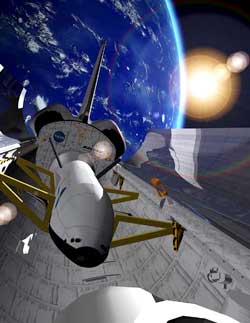In the news (2004) it is also written that Scale Composite will be involved in the development of the plane, as of 2015 it is not involved in it. It is all now in the hands of the US Army.

NASA has transferred the X-37 space plane project, which is in the phase of proving technological capability, to the Pentagon's Defense Advanced Research Projects Agency (DARPA), which plans to continue with atmospheric launch tests of the prototype next year. NASA spokesman Michael Braukus said that the agency will remain involved in the X-37 project, but DARPA will be the one to run the project.
The local newspaper "DESERT NEWS" which covers the Mojave Desert area reported that the experimental space plane will be put up for a test descent by the "White Knight" - the plane made by Scaled Composites, which carried the Spaceship-1 spacecraft for the first historic private manned flight to sub-orbit.
Braukos said that Scaled Composites will be involved in an attempt to land the X-37 next year, but did not say whether the test will be carried out using the "White Knight". So far, NASA has used a B-52 type aircraft for all launch attempts of test landing aircraft. The decision will have to be made by the agency responsible for the plane. "Cost-benefit analyzes favor scaled composites," Braukos said.
Scaled Composites spokeswoman Kay LaFabre would not confirm the company's involvement in the casting experiment. The company, a partnership between Paul Allen and Brett Rutan that owns the SpaceShip-1 spacecraft and the plane carrying it, recently announced that it will conduct the first official test in an attempt to win the $10 million X-PRIZE on September 29.
NASA has been involved in the development of the X-37 spacecraft since 1998, when the project was selected as the first in a series of spacecraft demonstrations dubbed the Future X. At the same time, NASA agreed to share the cost of the $173 million project with Boeing and the Air Force. After the Air Force announced in 2001 that it stopped funding the project, NASA informed Boeing that it must find another funder to continue the project. After pressure from Congresswoman Dana Rohrberger, a Republican from California, NASA awarded Boeing a $2002 million contract in 301 to build two X-37s in one location. One of these aircraft is scheduled to perform a series of atmospheric launch tests, paving the way for a flight to and from orbit in 2006.
However, at the end of 2003, NASA ordered Boeing to stop the development of the second plane and finally ordered Boeing to stop working on the project completely. X-37 was discussed and again it was decided to stop it as part of a committee that examined NASA's projects on the grounds that it did not fit the agency's new space agenda.
Braukos said that the second spacecraft - the one that will reach orbit will not be built yet, but the spacecraft designed for experiments inside the atmosphere will return to business orbit now that NASA has found a new partner interested in leading the project. According to Braukos, NASA has so far spent an amount of 325 million dollars on the project.
Boeing spokesman Ed Mem said the project was transferred from Boeing's NASA Systems Department to the Space and Intelligence Systems Department.
